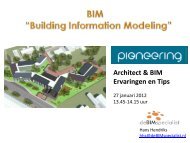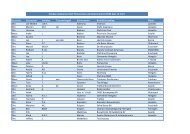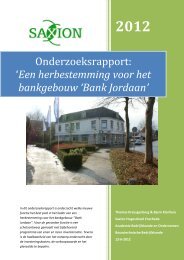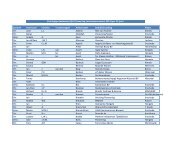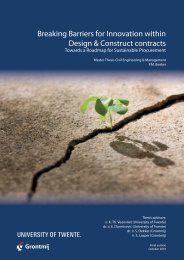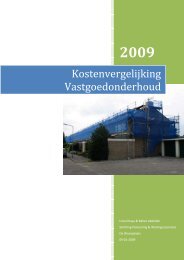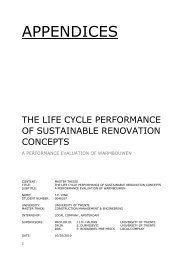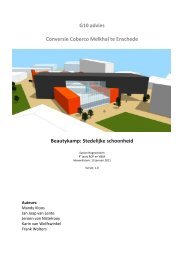the life cycle performance of sustainable renovation concepts
the life cycle performance of sustainable renovation concepts
the life cycle performance of sustainable renovation concepts
- No tags were found...
Create successful ePaper yourself
Turn your PDF publications into a flip-book with our unique Google optimized e-Paper software.
4.2.2 WHATThe model that is presented in figure 28 can be used to determine <strong>the</strong> <strong>performance</strong> <strong>of</strong><strong>sustainable</strong> <strong>renovation</strong> <strong>concepts</strong> on <strong>the</strong> basis <strong>of</strong> a <strong>life</strong> <strong>cycle</strong> approach. The <strong>life</strong> <strong>cycle</strong>approach refers to a cradle-to-cradle consideration <strong>of</strong> <strong>the</strong> <strong>performance</strong> on <strong>the</strong> definedsustainability aspects for <strong>renovation</strong> <strong>concepts</strong>. Hereby, <strong>the</strong> cradle-to-cradle approachrefers to <strong>the</strong> potential advantages <strong>of</strong> reuse and up-cycling <strong>of</strong> materials and components.Therefore, <strong>the</strong> model is defined as a “<strong>life</strong> <strong>cycle</strong> <strong>performance</strong> evaluation model” for<strong>sustainable</strong> <strong>renovation</strong> <strong>concepts</strong>.The “<strong>life</strong> <strong>cycle</strong> <strong>performance</strong>” is composed by a <strong>renovation</strong> concept‟s <strong>life</strong> <strong>cycle</strong>:- <strong>performance</strong> on environmental aspects- <strong>performance</strong> on economic aspects, which consists <strong>of</strong>:• <strong>performance</strong> on <strong>life</strong> <strong>cycle</strong> costs• <strong>performance</strong> on <strong>life</strong> <strong>cycle</strong> yields- <strong>performance</strong> on quality aspects- energy <strong>performance</strong>Application <strong>of</strong> <strong>the</strong> model results in a comparison <strong>of</strong> <strong>the</strong> <strong>life</strong> <strong>cycle</strong> <strong>performance</strong> <strong>of</strong><strong>renovation</strong> alternatives for a specific project. The model draws a distinction betweenprojects, because every <strong>renovation</strong> project is unique. As a result, <strong>the</strong> <strong>performance</strong> <strong>of</strong> a<strong>renovation</strong> concept, and <strong>the</strong>reby its feasibility and desirability can differ per project.The <strong>life</strong> <strong>cycle</strong> <strong>performance</strong> evaluation model integrates five main <strong>performance</strong> aspectsand boundary conditions. Figure 29 presents <strong>the</strong>se five main aspects and <strong>the</strong> boundaryconditions. Appendix L shows a complete breakdown structure <strong>of</strong> <strong>the</strong> model and itsunderlying factors.BoundaryconditionsBoundaryfactorsLife CyclePerformanceLife CycleCostsLife CycleYieldsLife CycleEnvironmentalImpactQualityEnergyPerformanceCoefficientMainfactorsFIGURE 29 - MODEL ASPECTS4.2.3 WHYThis paragraph explains <strong>the</strong> „why‟ questions that are stated in figure 27. First, an answeris provided on <strong>the</strong> question: “Why is <strong>the</strong> model developed?”First, <strong>the</strong> evaluation <strong>of</strong> existing sustainability assessment tools in <strong>the</strong> Ne<strong>the</strong>rlands(appendix M) points out that <strong>the</strong> current existing models are mainly useful to determine<strong>the</strong> sustainability <strong>of</strong> new development projects. As a result, <strong>the</strong>se models are not- or lessuseful for <strong>the</strong> evaluation <strong>of</strong> <strong>sustainable</strong> <strong>renovation</strong> <strong>concepts</strong>.Secondly, <strong>the</strong> existing tools are incomplete. The existing models only focus on one or afew aspects that are relevant for <strong>the</strong> <strong>performance</strong> <strong>of</strong> <strong>sustainable</strong> <strong>renovation</strong> <strong>concepts</strong>.Thus, none <strong>of</strong> <strong>the</strong> current models provides a comprising view on <strong>the</strong> <strong>performance</strong> <strong>of</strong> a<strong>sustainable</strong> <strong>renovation</strong> concept.48



